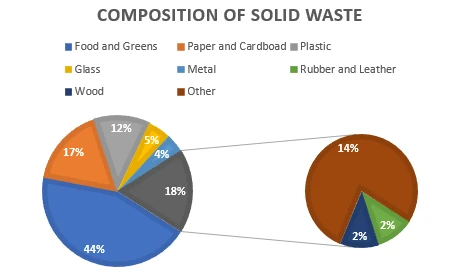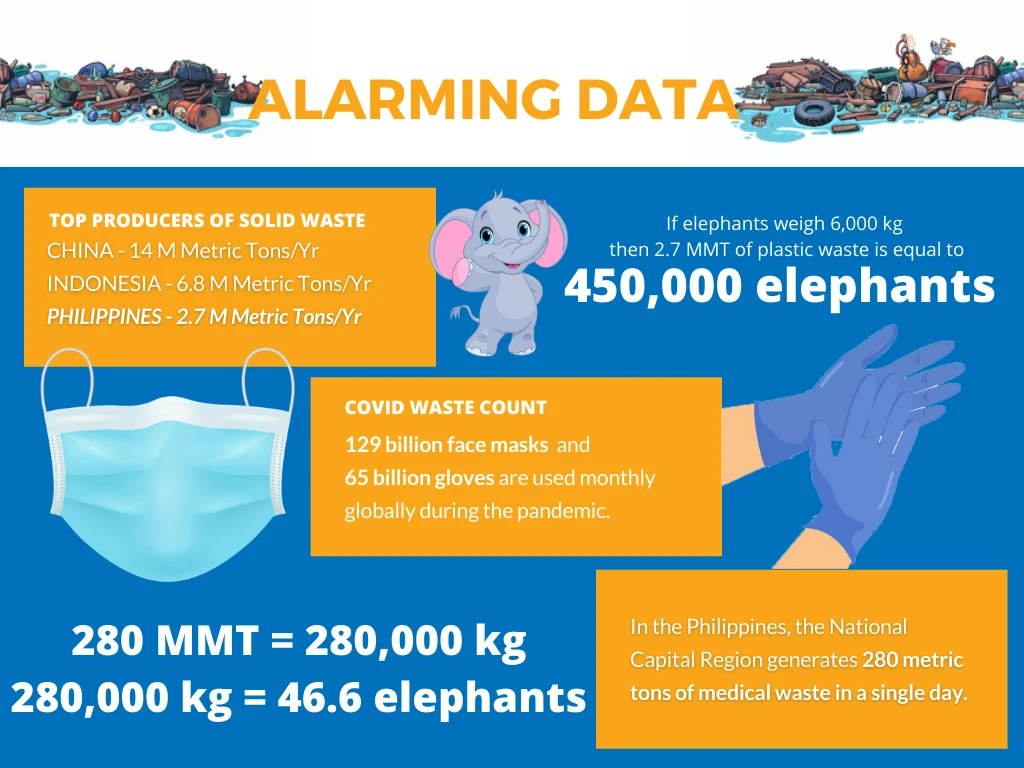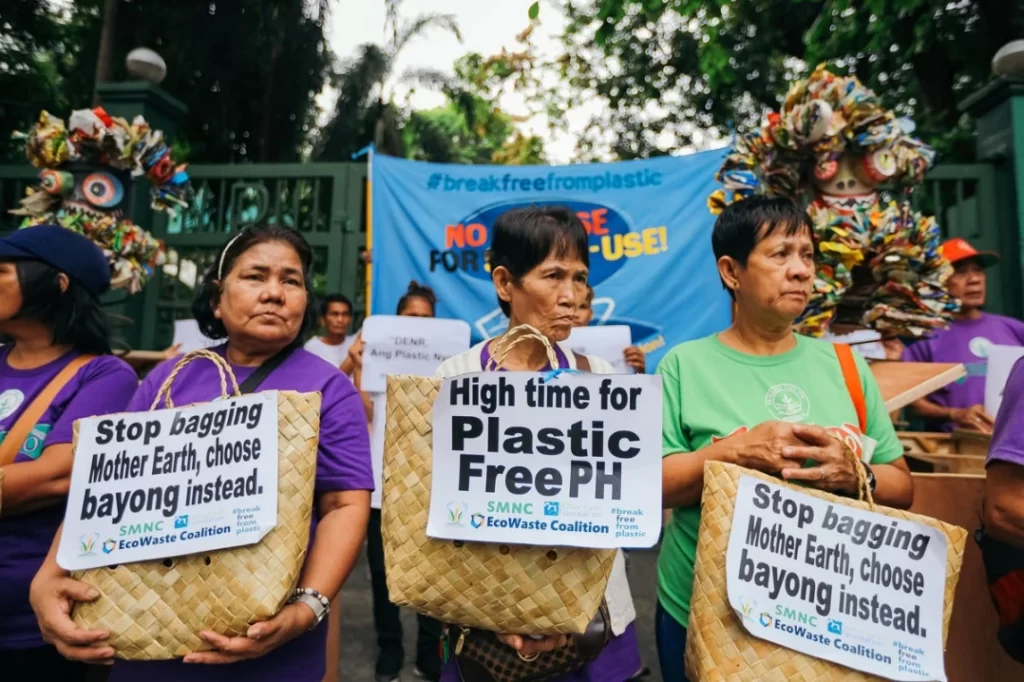By: Hans Ethan Carbonilla, Punkhuri Kumar
When we see waters from the river flowing, lakes being calm, waterfalls roaring, the first thing that comes to mind is how picturesque the scenery is. We usually take photos and post them on our social media accounts. Travel goals. The beauty deserves no filter.
But the reality is more than what meets the eye. Behind every country’s grandeur, is an increasing environmental problem that poses much danger to our home, the planet Earth.
The Alarming Dilemma
As per the United Nations Environment Programme, 11.2 billion tonne of solid waste is collected worldwide and this contributes to nearly 5% of global greenhouse gas emissions. Simply put, solid wastes are unwanted solid materials generated from human activities domestically and commercially. It is a wide category that encompasses numerous different kinds of waste made up of different materials. The pie chart below shows the kinds of solid wastes generated globally in 2016.

Therefore, the largest contributors to solid wastes are food and greens; something that would be generated in every home globally. As per World Bank data, high income countries that account for only 16 % of global population generate almost 34 % of global solid waste. They found a high correlation between income levels and waste generation. Waste generation initially decreases with increase in income post which it again increases steadily.
However, it is the low-income countries that generally do not have the means or technology to dispose off properly the solid wastes, some of which comprise harmful materials like medical wastes and non-biodegradable plastics.
The harm that they cause to the environment is immense. They are unhygienic and are a source of pathogen collection and disease. The plastic waste generated is deadly for animals. It enters water bodies and impacts the marine life to name a few. Therefore, the management of solid waste becomes an important policy issue for most countries given the sheer amount of waste that is being generated as can be seen from the infographics below.

Most of our methods of waste disposal are not eco-friendly. Burning of wastes is extremely common, the smoke through which is a potent source of air pollution. Another common means is disposal through landfills. Disposal through landfills is seen as a simple and cheap method for waste disposal.
However, if toxic waste is disposed in these areas, it can impact groundwater supply and may even be deadly to those living in nearby areas. Dumping of wastes in sea bodies is a terrible method for obvious reasons.
The Increasing COVID Wastes
While diving into the stillness of the Philippine Trench, Filipino Oceanographer Deo Florence Onda and American Explorer Victor Versovo did not expect to see that even the deepest portions of the world are not safe from solid wastes. At a depth of 10,045 meters or more than 33 Eiffel Towers, both were shocked to find a stuffed teddy bear, plastic bags, and clothes that seemed fresh and new, half buried in the sediment.

After China and Indonesia, the Philippines hits third as the world’s biggest plastic polluter with 2.7 million metric tons or approximately 2,700,000,000 kilograms of solid waste generated every year.
Another example is the Ghazipur landfill of New Delhi, India. In 2019, it had a height of 65 metres and it caved in killing two people. Since then, by the efforts of the Municipal Corporation, the height of the landfill has been reduced, but yet 2500 MT of solid waste continues to be dumped at the landfill site every day!
The problem of solid waste is also getting worse during the Covid-19 pandemic as the usage of single-use plastic has skewed the trend of waste generation. Personal protection equipment (PPE) such as facemasks and disposable gloves are found scattered across the sea beds.
Cited from the study of Environmental Science and Technology published last June 2020, a calculated number of 129 billion face masks and 65 billion gloves are used monthly globally during the pandemic.
The Asian Development Bank reported that the hospitals in the National Capital Region is expected to generate 280 metric tons of medical waste in a single day. This is the region that is responsible for the approximately 55% of the country’s COVID cases.
Even though the PPEs are necessities in this time and age, but those masks and gloves used by the ordinary masses are not disposed properly. Moreover, the mandatory face shields and public dividers in public transportation and establishments are entirely made from plastic.
Disturbing. The rising number poses not just an alarming environmental problem but a danger to public health. The COVID wastes are vectors for the COVID-19 virus, which survives until three days on plastics.
It has been a year since the start of the pandemic, and if the trend will continue to grow, it will presumptively spark a surge in ocean and land pollution. Dangerous.
Eco-Friendly Solutions
1. Comprehensive Guidelines and Systems on COVID Wastes
There should be proper guidelines and systems that must be imposed in every community to ensure that PPEs worn by the public are not discarded anywhere and fall into a grey area between “general waste” and “medical waste.”
This can be done by holding press conferences, public service announcements, and webinars on different social media platforms to educate the public on how to dispose PPEs properly. In addition to that, there should be a reinforcement on environmental laws to ensure that these types of wastes are supervised efficiently.
Comprehensive guidelines and systems, if imposed with utmost security and enforcement, can maintain a balance between public safety/health and environmental sustainability.
2. Reinforced Material Recovery Facility
Under the Ecological Solid Waste Management Act of 2001, communities in the Philippines were obliged to establish Material Recovery Facilities to segregate garbage and recover materials that are still recyclable. Suddenly, this captured little to no degree of accomplishment. It is because the communities lack understanding on the design and operation of MRF.

However, there are still communities in the country with functional MRF that serves as their recycling bank for income-generating projects. It lets them incorporate resourcefulness, creativity, and skills for entrepreneurship. It is a great blend of art and sustainability in the sense of making recycled products out of the ordinary wastes.
In 2019, a Municipality in Eastern Samar, did not fail to realize the significant purpose of MRF. The Local Government Unit of Arteche in cooperation with the people and other organizations utilized plastic bottles and shredded plastic wrappers from the MRF to create eco-bricks. These eco-bricks were used in the construction of local projects such as dog pound houses and community beautification.
3. Extended Producer Responsibility
Extended Producer Responsibility is a policy where producers of goods have the responsibility for treatment and disposal of the waste produced post consumption of the goods. The cost of disposal shifts from the government to the producers. This also acts as an incentive for producers to use sustainable environment friendly materials.
Here, the waste generators are required to collect back the waste through means of a Producer Responsibility Organisations and then take care of recycling or healthy disposal.
For instance, in India, most of the waste is collected by informal rag pickers. They recycle this waste to make money. However, as has been reported, about 7 to 9 million tonnes of plastic waste is not picked including the harmful multilayered packaging that cannot be easily recycled. EPR companies can formalise this sector and incentivise the rag-pickers to pick even these kinds of waste.
Therefore, applying a polluter pays principle could ensure more organised treatment and disposal of solid waste.

4. Moving to more Eco-friendly options.
There needs to be a conscious change in lifestyle to reduce usage of things made of harmful polluting material and replace them with more eco-friendly options. For example, the current movement towards doing away with plastic straws in favour of paper ones in most cafes, using cloth bags as against plastic ones or banning of plastic water bottles as has been done in few Indian cities.
5. Encouraging Composting
As mentioned before, composting is one of the best ways to get rid of organic solid waste, one of the largest components of solid waste. Children should be encouraged to take up composting and recycling activities in schools as part of projects. Communities and resident associations should be encouraged to do the same. Governments could incentivize fertilizer businesses making composts of such kinds.
Global waste is expected to grow to 3.40 Billion tonnes by 2050, more than double the population growth. One mismanaged plastic waste is already a huge problem. We still have time to avoid this impending dilemma.
There are a lot of living things out there struggling to live because of our actions. Climate change is happening, and we should be bothered. In this world, we should be reminded that we are not alone. The fight is not yet over. It starts within us to realize the hopeful dream of a plastic-free world.


